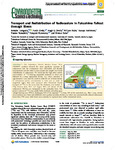Transport and Redistribution of Radiocesium in Fukushima Fallout through Rivers
| dc.contributor.author | Taniguchi, K | |
| dc.contributor.author | Onda, Y | |
| dc.contributor.author | Smith, HG | |
| dc.contributor.author | Blake, William | |
| dc.contributor.author | Yoshimura, K | |
| dc.contributor.author | Yamashiki, Y | |
| dc.contributor.author | Kuramoto, T | |
| dc.contributor.author | Saito, K | |
| dc.date.accessioned | 2020-07-09T08:55:49Z | |
| dc.date.available | 2020-07-09T08:55:49Z | |
| dc.date.issued | 2019-11-05 | |
| dc.identifier.issn | 0013-936X | |
| dc.identifier.issn | 1520-5851 | |
| dc.identifier.uri | http://hdl.handle.net/10026.1/15896 | |
| dc.description.abstract |
The Fukushima Daiichi Nuclear Power Plant (FDNPP) accident released the most significant quantity of radiocesium into the environment since Chernobyl, and detailed measurements over the initial 5 years provide new insights into fluvial redistribution of radiocesium. We found that the high initial activity concentration of 137Cs-bearing suspended sediment in rivers was followed by a steep exponential decline (λ1) which extended to approximately 1 year after the accident, while the rate of initial decline in radiocesium activity concentration in water was an order of magnitude higher than rates measured after Chernobyl. Fluvial transport of 137Cs to the ocean from the Abukuma river totaled 12 TBq between June 2011 and August 2015 and almost all this radiocesium (96.5%) was transported in the particulate form. The primary sources of 137Cs were paddy fields, farmland, and urban areas [plaque-forming unit (PFU)], discharging 85% of the exported 137Cs from 38% of the watershed area. After 1 year, activity concentrations were lower and exhibited a more gradual secondary decline (λ2) which was associated with reduced radiocesium losses from PFU areas, while forest areas continue to represent more stable contaminant stores. | |
| dc.format.extent | 12339-12347 | |
| dc.format.medium | Print-Electronic | |
| dc.language | en | |
| dc.language.iso | en | |
| dc.publisher | American Chemical Society (ACS) | |
| dc.subject | Cesium Radioisotopes | |
| dc.subject | Fukushima Nuclear Accident | |
| dc.subject | Japan | |
| dc.subject | Radiation Monitoring | |
| dc.subject | Rivers | |
| dc.subject | Soil Pollutants, Radioactive | |
| dc.subject | Water Pollutants, Radioactive | |
| dc.title | Transport and Redistribution of Radiocesium in Fukushima Fallout through Rivers | |
| dc.type | journal-article | |
| dc.type | Journal Article | |
| plymouth.author-url | https://www.webofscience.com/api/gateway?GWVersion=2&SrcApp=PARTNER_APP&SrcAuth=LinksAMR&KeyUT=WOS:000495467500021&DestLinkType=FullRecord&DestApp=ALL_WOS&UsrCustomerID=11bb513d99f797142bcfeffcc58ea008 | |
| plymouth.issue | 21 | |
| plymouth.volume | 53 | |
| plymouth.publication-status | Published | |
| plymouth.journal | Environmental Science & Technology | |
| dc.identifier.doi | 10.1021/acs.est.9b02890 | |
| plymouth.organisational-group | /Plymouth | |
| plymouth.organisational-group | /Plymouth/Admin Group - REF | |
| plymouth.organisational-group | /Plymouth/Admin Group - REF/REF Admin Group - FoSE | |
| plymouth.organisational-group | /Plymouth/Faculty of Science and Engineering | |
| plymouth.organisational-group | /Plymouth/Faculty of Science and Engineering/School of Geography, Earth and Environmental Sciences | |
| plymouth.organisational-group | /Plymouth/REF 2021 Researchers by UoA | |
| plymouth.organisational-group | /Plymouth/REF 2021 Researchers by UoA/UoA14 Geography and Environmental Studies | |
| plymouth.organisational-group | /Plymouth/Research Groups | |
| plymouth.organisational-group | /Plymouth/Research Groups/Marine Institute | |
| plymouth.organisational-group | /Plymouth/Users by role | |
| plymouth.organisational-group | /Plymouth/Users by role/Academics | |
| plymouth.organisational-group | /Plymouth/Users by role/Researchers in ResearchFish submission | |
| dc.publisher.place | United States | |
| dcterms.dateAccepted | 2019-09-06 | |
| dc.rights.embargodate | 2020-7-11 | |
| dc.identifier.eissn | 1520-5851 | |
| dc.rights.embargoperiod | Not known | |
| rioxxterms.versionofrecord | 10.1021/acs.est.9b02890 | |
| rioxxterms.licenseref.uri | http://www.rioxx.net/licenses/all-rights-reserved | |
| rioxxterms.licenseref.startdate | 2019-11-05 | |
| rioxxterms.type | Journal Article/Review |


